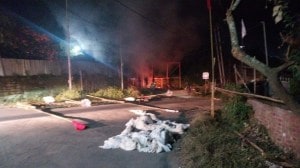First account of Indian scientists on winter expedition to Arctic: No sun, no phones, and polar bears for company
Less than a week after India flagged off its first winter scientific expedition (November to March) to the Arctic, commencing year-round observations in Svalbard – a sort of a ‘science village’ and the designated place for global scientific research – the team spoke to The Indian Express over video.
 Members of India’s first winter scientific expedition to the Arctic at the Himadri research station in NyÅlesund, Svalbard, on December 21. (Source: NCPOR)
Members of India’s first winter scientific expedition to the Arctic at the Himadri research station in NyÅlesund, Svalbard, on December 21. (Source: NCPOR)“It’s 9.30 in the morning… and if you look outside the window, it’s completely dark, pitch black. That’s the first thing that went through our minds after landing in the Arctic – there is just darkness and snow,” said B S Girish over a video call from Himadri, India’s permanent research station in the Norwegian archipelago of Svalbard, the world’s northernmost inhabited place.
Less than a week after India flagged off its first winter scientific expedition (November to March) to the Arctic, commencing year-round observations in Svalbard – a sort of a ‘science village’ and the designated place for global scientific research – the team spoke to The Indian Express over video.
 A photo of the Himadri research station from an earlier expedition. (Photo: Special Arrangement)
A photo of the Himadri research station from an earlier expedition. (Photo: Special Arrangement)
The sun set in the Arctic around the third week of October, and will not rise till the end of February or early March.
“Whenever we step out, a thought crops up that maybe tomorrow morning, the sun will be out and we can explore. A minute later, it sets in that… there will be no sunlight here, not for the next few months. So, we are gradually getting used to that,” said Girish, who is part of the first batch of four researchers – from the National Centre for Polar and Ocean Research (NCPOR), the Indian Institute of Technology — Mandi, the Indian Institute of Tropical Meteorology — Pune, and Raman Research Institute — Bengaluru.
They reached the Himadri base at NyÅlesund, located 1,231 km south of the North Pole, on Thursday.
“We can imagine the beauty outside our station, but we can’t see or admire it. I am from Rajasthan. The temperature there currently is 24 degrees Celsius and here it goes to -24 degrees Celsius. It’s like X-axis and Y-axis,” said Surendra Singh from IITM-Pune.
For the next three weeks, the researchers will study atmospheric lightning phenomenon over the Arctic in winter, precipitation and the role of climate change on the region, the role of atmospheric aerosols on polar climate, and radio-wave signals from outer space.
India’s research station in the Arctic, Himadri, began operations in 2008 and has since hosted scientists mostly during spring, summer and autumn months.
 Summer in NyÅlesund town during an earlier expedition. (Photo: Special Arrangement)
Summer in NyÅlesund town during an earlier expedition. (Photo: Special Arrangement)
Dr Thamban Meloth, director, NCPOR Goa, the nodal agency for India’s polar expeditions, said, “We had been avoiding wintering in the Arctic because it gets very dark… It’s colder, windier and outdoor field activities are restricted because there is no light. So, we were missing a key part of the year in the Arctic and wanted to have a continuous data set to fill the gap of data deficiency during winter polar nights.”
“The darkness is important – for instance, for those who want to study space or northern lights (aurora borealis). The trans-continental dust that comes from other continents to the Arctic, that also happens typically during winter time. What happens to microbial life during winters? We don’t know. So, we were missing this data,” he said.
Please mind the bears
“Contact the watchman if you see a polar bear inside NyÅlesund or close to town,” read a recent warning issued by the Norwegian government-owned enterprise that provides infrastructure support to researchers at the base.
Soon after the team reached Svalbard, they were given a list of dos and don’ts and cautioned against venturing beyond the ‘safe zone’ due to the lurking threat of polar bears. In addition, due to several territorial jurisdictions governing the region, there is limited space for exploration, particularly as compared to expeditions in the Antarctic. Meals for scientists from all the countries are served at a common service area, and travel to the Gruvebadet atmospheric laboratory is facilitated by a snow scooter.
“We can only go in the diameter of, say, one or two kilometres of our station. If we go outside that zone, we have to be accompanied by an escort guard due to polar bears,” said Singh.
Until a few years ago, scientists underwent rifle training certification due to the threat from polar bears.
Dr Rohit Srivastava, in-charge of the expedition logistics at NCPOR, said researchers used to apply for a permit to borrow a firearm from the Governor of Svalbard.
 A photo of the Himadri research station from an earlier expedition. The station was inaugurated on July 1, 2008. (Source: Rohit Srivastava/NCPOR)
A photo of the Himadri research station from an earlier expedition. The station was inaugurated on July 1, 2008. (Source: Rohit Srivastava/NCPOR)
“In 2019, when I was at the Himadri station in summer, a polar bear had come within 50 metres of the station, possibly looking for food. The rifle training was discontinued a couple of years ago after the pandemic and due to issues concerning international licence for guns. Now, we hire security personnel for safety, who can accompany researchers, if required,” he said.
Athulya R from NCPOR said the lack of area for exploration would not be an impediment for research. “This batch comprises scientists from domains of space sciences, radio astronomy and atmospheric sciences. So, we don’t have to roam around a lot to get samples. We will be able to share our experiences and feedback with later batches, who require more sampling, on how they can conduct a more thorough study in darkness,” she said.
Singh, who has been to three expeditions in Antarctica and is studying atmospheric lightning phenomenon over the Arctic during winter, said, “Antarctica is a big continent, governed by the Antarctic treaty, and any country can go there and conduct experiments. It’s quite different here (in the Arctic). In Antarctica, there is no threat from wild animals… the penguins are friendly.”
 Members of India’s first winter scientific expedition to the Arctic celebrating Christmas at the Service Building with researchers from other stations. (Source: NCPOR/Twitter)
Members of India’s first winter scientific expedition to the Arctic celebrating Christmas at the Service Building with researchers from other stations. (Source: NCPOR/Twitter)
Radio silence
The Arctic station is located in a “radio silent” zone, meaning the use of all wireless devices, including mobile phones, WiFi and Bluetooth, is prohibited to prevent disturbance or destruction of highly sensitive instruments and measurements in the area.
“Our phones haven’t rung for a week. We are just using them to check the time. The phone is just a box now. But, we do have access to the internet on the computer,” said Prashant Rawat of IIT-Mandi.
Scientists said the year-round operations at the Arctic will help address the knowledge gap and data deficiency during polar nights, especially due to effects of climate change in the Arctic over the past few decades.
 A photo of the Gruvebadet atmospheric laboratory seen during an earlier expedition. (Source: Rohit Srivastava/NCPOR)
A photo of the Gruvebadet atmospheric laboratory seen during an earlier expedition. (Source: Rohit Srivastava/NCPOR)
Athulya, who is studying how global warming affects Arctic precipitation, said that due to lack of proper maintenance or staff at the station, the winter data was often lost. “Winter is important because the Arctic has been warming tremendously rapidly especially in the season, which is called the ‘Arctic amplification’.”
“The major threat is melting of sea ice and glaciers, and reduced snow cover. Its impact will be a rise in sea levels. Whatever is happening in the Arctic is not going to stay in the Arctic… it will affect the globe. That is why nations are taking more interest in the Arctic now,” she said.
 Members of India’s first winter scientific expedition to the Arctic celebrating Christmas at the Service Building with researchers from other stations. (Source: NCPOR/Twitter)
Members of India’s first winter scientific expedition to the Arctic celebrating Christmas at the Service Building with researchers from other stations. (Source: NCPOR/Twitter)
Explaining his role in the expedition, Girish from RRI-Bengaluru said, “At RRI, we have a project called SARAS, where we are studying signals (to understand) the evolutionary history of the universe, when stars and galaxies were first formed… It is becoming increasingly difficult to find proper sites to conduct experiments and to collect data, and one of the major issues we face is contamination of signals by emissions from communication equipment… So we are trying to see if a remote place around the Himadri can be a pristine environment in terms of radio frequency interference to deploy the SARAS experiment.”
So far, the team has not been able to see Aurora Borealis or The Northern Lights – a dynamic pattern of lights which appear as curtains, rays and flickers covering the entire sky. The reason, they said, is the moonlight. “The moon is pretty big and bright. Maybe we will wait for 10 more days when the skies are dark. Then we might get a chance to see it,” said Singh.








